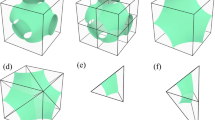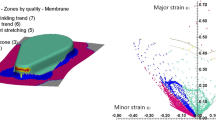Abstract
Stresses remaining in the component after sheet metal forming processes can result in complex form errors, such as springback and torsions. In order to compensate these process-induced deformations, the local and global deformations have to be analyzed. Hence, an appropriate comparison between the actually manufactured and the target design is required. For this purpose, the surface of the actual workpiece is scanned and the so-obtained scan points have to be assigned to corresponding points of the target shape defined by the workpiece model. From these correspondences, a field of deformation vectors can be computed which represents the basis for the compensation strategy. The task of finding appropriate correspondences is called registration. It is usually solved using rigid transformations, i.e., translation and rotation. Due to the locality, strength and complexity of the deformations, rigid transformations are usually not sufficient. As a more flexible alternative, a procedure for non-rigid registration is presented in this paper. Therein, isometry, i.e., the conservation of distances between corresponding points within an appropriate neighborhood structure, is defined as the objective function. The procedure consists of three steps: definition of the neighborhood structure, global registration, and local reoptimization. The main focus of the paper is set to the latter, where an adapted gradient descent method also allowing projections into the triangles of the target shape is presented and experimentally validated. With these three steps, an assignment between both shapes can be calculated, even for strong local deformations and coarse triangular meshes representing the workpiece model.








Similar content being viewed by others
References
Amberg B, Romdhani S, Vetter T (2007) Optimal step nonrigid ICP algorithms for surface registration. In: IEEE conference on computer vision and pattern recognition, pp 1–8. doi:10.1109/CVPR.2007.383165
Anstreicher K (2003) Recent advances in the solution of quadratic assignment problems. Math Program B 97:27–42
Besl P, McKay N (1992) A method for registration of 3-d shapes. IEEE Trans Pattern Anal Mach Intell 14(2):239–256
Biermann D, Sacharow A, Surmann T, Wagner T (2010) Direct free-form deformation of NC programs for surface reconstruction and form-error compensation. Prod Eng Res Dev 4(5):501–507
Biermann D, Surmann T, Sacharow A, Skutella M, Theile M (2008) Automated analysis of the form error caused by springback in metal sheet forming. In: Proceedings of the 3rd international conference on manufacturing engineering, pp 737–746
Bronstein A, Bronstein M, Kimmel R (2006) Generalized multidimensional scaling: a framework for isometry-invariant partial surface matching. Proc Natl Acade Sci 103(5):1168–1172
Çela E (1998) The quadratic assignment problem—theory and algorithms. Kluwer Academic, Dordrecht, The Netherlands
Chen Y, Medioni G (1991) Object modeling by registration of multiple range images. In: Proceedings of the IEEE international conference on robotics and automation, vol 3, pp 2724–2729
Elad A, Kimmel R (2003) On bending invariant signatures for surfaces. IEEE Trans Pattern Anal Mach Intell 25(10):1285–1295
Gan W, Wagoner R (2004) Die design method for sheet springback. Int J Mech Sci 46(7):1097–1113
Garey MR, Johnson DS (1979) Computers and intractability: a guide to the theory of NP-completeness. W. H. Freeman, New York
Horn BKP (1987) Closed-form solution of absolute orientation using unit quaternions. J Opt Soc Am A 4(4):629–642
Hussain M (2013) Volume and normal field based simplification of polygonal models. J Inf Sci Eng 29(2):267–279
Kleiner M, Tekkaya A, Chatti S, Hermes M, Weinrich A, Ben-Khalifa N, Dirksen U (2009) New incremental methods for springback compensation by stress superposition. Prod Eng Res Dev 3(2):137–144
Lawler EL (1963) The quadratic assignment problem. Manag Sci 9(4):586–599. doi:10.1287/mnsc.9.4.586
Mémoli F, Sapiro G (2005) A theoretical and computational framework for isometry invariant recognition of point cloud data. Found Comput Math 5(3):313–347
Nocedal J, Wright S (2006) Numerical optimization, 2nd edn. Springer, Berlin
Sacharow A, Balzer J, Biermann D, Surmann T (2011) Non-rigid isometric ICP: a practical registration method for the analysis and compensation of form errors in production engineering. Comput Aided Des 43(12):1758–1768. doi:10.1016/j.cad.2011.07.007
Selimovic I (2006) Improved algorithms for the projection of points on NURBS curves and surfaces. Comput Aided Geom Des 23:439–445
Tam GKL, Cheng ZQ, Lai YK, Langbein FC, Liu Y, Marshall D, Martin RR, Sun XF, Rosin PL (2013) Registration of 3d point clouds and meshes: a survey from rigid to non-rigid. IEEE Trans Vis Comput Graph. doi:10.1109/TVCG.2012.310
Wagner T, Michelitsch T, Sacharow A (2007) On the design of optimisers for surface reconstruction. In: Thierens D, et al (eds) Proceedings of 9th annual genetic and evolutionary computation conference (GECCO 2007). ACM, New York, NJ, London, UK, pp 2195–2202. doi:10.1145/1276958.1277379
Weiher J, Rietman B, Kose K, Ohnimus S, Petzoldt M (2004) Controlling springback with compensation strategies. In: AIP conference proceedings, pp 1011–1015
Acknowledgments
This work is funded as subproject C4 of the Collaborative Research Center “3D-Surface Engineering” (SFB 708) by the German Research Foundation (DFG). Elias Kuthe and Cesaire Fondjo are acknowledged for their participation in the implementation and experimental evaluation of the presented local reoptimization algorithm.
Author information
Authors and Affiliations
Corresponding author
Rights and permissions
About this article
Cite this article
Klein, L., Wagner, T., Buchheim, C. et al. A procedure for the evaluation and compensation of form errors by means of global isometric registration with subsequent local reoptimization. Prod. Eng. Res. Devel. 8, 81–89 (2014). https://doi.org/10.1007/s11740-013-0510-2
Received:
Accepted:
Published:
Issue Date:
DOI: https://doi.org/10.1007/s11740-013-0510-2




